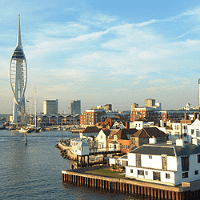There are 13,800 homes under construction or with planning consent in the M27 corridor. If the current building rate continues, it will take four and a half years for those new homes to be delivered.
Given that the current Strategic Housing Market Assessments (SHMAs) for the six LAs identify the need for 4,000 new homes per year (and this may be an undercount), at least 20,000 new homes will be needed over the next five years. If supply of new homes does not increase, the area will be some 4,600 homes short.
Portsmouth and Southampton
Development in Portsmouth is very constrained by its coastal location and a tightly drawn boundary to the north. It must therefore rely on brownfield redevelopment.
Southampton, by contrast, has some potential for urban extension to the north in addition to regeneration of brownfield sites. Both cities have need for additional housing. However, the market risk can be too great for developers to build flat led schemes required to provide homes for sale within the city centres.
Alternative residential models, such as Build to Rent are becoming more common. The Build to Rent model has a lower risk profile than building for sale, however it still faces challenges such as Stamp Duty.
There are a number of Build to Rent schemes in the pipeline in both Southampton and Portsmouth. For instance, the redevelopment of the former Fruit and Vegetable Market in Southampton will provide 279 homes to rent in addition to business space.
Beyond the two cities
Eastleigh has a particularly large pipeline of homes which includes two big sites to the south east of Eastleigh close to the airport and Southampton Airport Parkway station (60 mins to London Waterloo): Chestnut Avenue (1,100 homes) and Boorley Green (1,400 homes). Another large site in the area, Horton Heath (950 homes), has a resolution to grant planning permission subject to S106.
Outside the M27 corridor, Winchester, Chichester and East Hampshire have a significant number of homes with permission, including the 2,000 home site at Barton Farm to the north of Winchester and the 2,400 home site at Bordon.
The more restrictive planning policies that apply in the South Downs National Park accentuate the need to provide homes in other parts of our study area.
.png)


.png)
